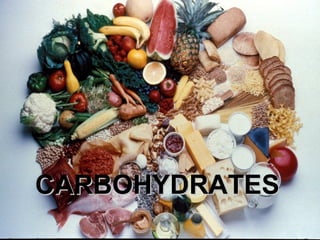
Carbohydrates
- 2. • Carbohydrate – this word means the same thing as sugar. sugar • Some examples of sugar are: • -Glucose • -Fructose • -Sucrose
- 3. • The basic unit, or building block of sugar is called a saccharide. saccharide • One molecule of saccharide has the molecular formula of • C6 H12 O6
- 4. • Saccharides can vary (ie the types of sugar vary) by where the OH’s are and how they are shaped. shaped • 1 molecule of saccharide = • monosaccharide • 2 molecules of saccharide = • disaccharide • >2 molecules of saccharide = • polysaccharide
- 5. • MONOSACCHARIDES • The most common example is glucose. glucose • 2 ways to write glucose’s structural formula are:
- 6. • Another monosaccharide is fructose. fructose
- 7. • DISACCHARIDES • Disaccharides results when you join two monosaccharides together • When this happens one monosaccharide loses an “H” and the other monosaccharide loses an OH.OH • OH + H = H2O (water) • When water is lost in the making of a new molecule, the process is called dehydration. dehydration • The resulting bond is called a glycosidic bond.
- 8. • POLYSACCHARIDES • Polysaccharides are thousands of monosaccharides hooked together. • For example, starch is a polysaccharide • -noodles, potatoes • -thousands of glucose molecules hooked together • Organisms can get energy from polysaccharide molecules by breaking the glycosidic bonds that hold all the monosaccharides together. • The bond is broken by adding H2O (OH + H) and is called hydrolisis.
- 9. • Another example is cellulose. cellulose • This is found in plant walls and wood (what plants have instead of bones)= cell wall • Humans can’t break the glycosidic bonds of cellulose. That is why we can’t cellulose eat trees. • They won’t digest in our stomachs. But we can break the glycosidic bonds of starch
- 10. • Another example is chitin. chitin • The hard shell on bugs (what they have instead of bones). • • Humans can’t break these bonds either.
